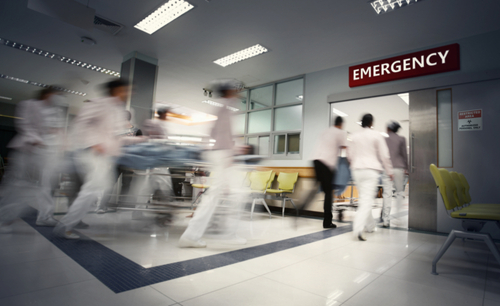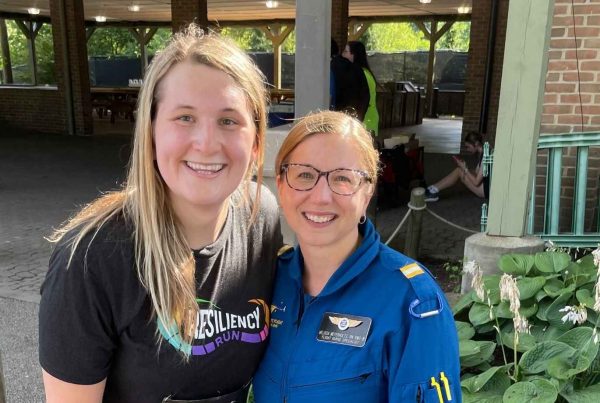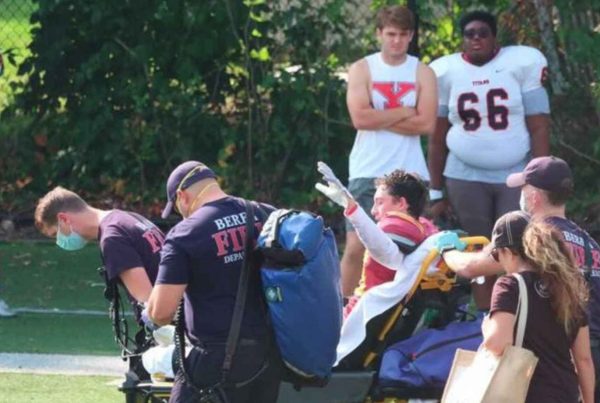Early surgery improves outcomes. At MetroHealth, patients with severe spinal cord injuries are safely in surgery two times faster than the national average.
On August 28, 2023, Tom Uhl was perched on a stepladder, 3 feet off the ground, putting gutter guards on his house. He had vowed that it was his last time doing that task by himself.
Before Tom could get off the ladder, the ground beneath him caved in. The ladder spun around and slammed him against a brick windowsill.
Tom landed hard on the ground. He couldn’t move anything, but he could speak and breathe. He tried to yell for help. His wife wasn’t home. No one heard him. After 30 minutes, Tom finally got the attention of a mail carrier, who called 911.
The assessment of the EMTs who arrived on the scene was that Tom had suffered a severe SCI. They told Tom they were transporting him to MetroHealth Medical Center, the region’s most experienced Level 1 Adult Trauma Center. It was less than 20 minutes from his house.
At 10 p.m., after lab tests and a CT scan confirmed the SCI diagnosis, and once Tom’s vital statistics were stable, he was brought into the operating room. Less than seven hours had passed from when Tom was first admitted. A team led by orthopedic spine surgeon Tim Moore, MD, was waiting to begin decompression of cervical spine surgery.
An individual who suffers an acute spinal cord injury (SCI) has a greater chance of regaining lost movement and function the sooner they get spine decompression surgery. The phrase “time is spine” is a reference to the importance of early surgical intervention. But many barriers – including initially not being transported to a hospital with the right technology and diagnostics – stand in the way of someone with an acute SCI of getting surgery within the first critical 24 hours.
“We get patients with spinal cord injuries into the OR in an average of 12 hours,” Dr. Moore said. “The national average is about 26 hours. As a trauma center, we do very well, especially with spinal cord injuries. We’ve made it a point to treat patients with SCI very expeditiously.”
During surgery, Dr. Moore removed pressure from the spinal cord in Tom’s neck with the hopes of preventing further nerve damage and allowing future recovery. Still, Tom’s family was told that the chances of him walking again were slim.
“I had planned for my retirement to be more active,” said Tom, whose 70th birthday was a few weeks away. The prognosis, he said, left him feeling “broken hearted.”
MetroHealth’s Physical Medicine and Rehabilitation (PM&R) physicians typically see patients with new SCI injuries within the first 72 hours of being admitted. James Wilson, DO, met Tom the day after his surgery and examined him.
Though still very weak, and although he hadn’t yet regained movement in many of his muscles, Tom was able to move his arms and legs slightly. During the initial PM&R evaluation, Tom’s total motor score (measure of strength in the arms and legs) was 26 out of 100.
Like many people after significant SCI, Tom was transferred to the MetroHealth Rehabilitation Institute’s dedicated SCI Unit. There he received SCI specific, intensive inpatient physical, occupational, and speech therapy as well as rehabilitation nursing, psychology, physician and other care.
Tom spent six weeks in therapy. “Every day they pushed me a little farther and harder,” he said. “I saw progress being made.”
Tom went home on October 12. He had demonstrated that he could get in and out of a car and travel 100 feet with a walker before having to sit down.
“Through the grace of God and the therapists, I was finally able to get up and walk out of the hospital,” he said.
The next day, he started outpatient physical and occupational therapy.
Five weeks later, Dr. Wilson repeated the motor score test. This time, Tom scored 88 out of 100. “Despite all the clinical trials and research, spinal cord injury still has no cure,” Dr. Wilson said. “Perhaps the only treatment shown to improve neurologic outcomes after injury is early surgical decompression. MetroHealth is proud to offer rapid surgery, specialized rehabilitation and lifelong follow up care for the SCI community of Northeast Ohio. We want to give people like Tom every chance to improve.”
By the time Tom had his 12-month follow-up appointment with Dr. Moore, he had completed outpatient therapy. His upper body function had improved a lot, and he was mostly walking without any assistance, and he had resumed driving.
For someone who before his injury had never gone to MetroHealth for any of his health care, Tom’s perception of it changed dramatically.
Today, Tom still does his therapy exercises, in addition to walking 2-3 miles a day and lifting weights at home.
He still cuts his own grass, rakes the leaves, and shovels or runs the snow blower. He accepts that the sensation and movement in his left hand may never go back to what it was before. It makes buttoning shirts, opening Ziploc bags and washing his car a challenge.
“If that’s the worst thing, so be it,” he said. “I’m pretty blessed that I’m able to accomplish the things I can do.”
Leaders in rehabilitation, research, and education to improve care for the most complex injuries and illnesses. Visit our website for more information about the MetroHealth Rehabilitation Institute or call:
- Outpatient appointments for adults and children, call 216-778-4414
- Inpatient services or admission for adults and children 13 yrs+, call 216-778-4167
Do you want to help patients like Tom? The MetroHealth Foundation is making a difference every day. Learn more or give at metrohealth.org/foundation.













